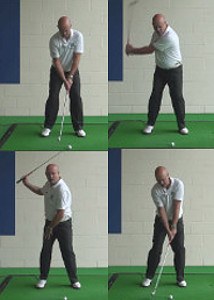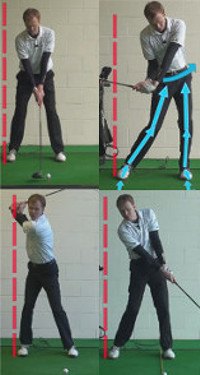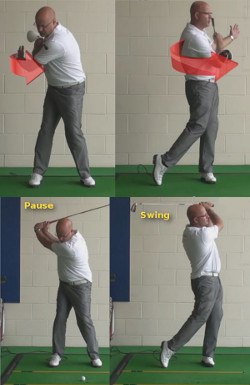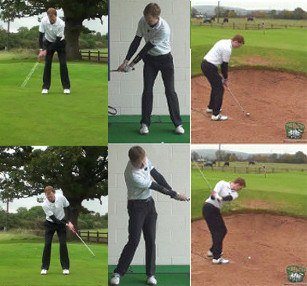The golf swing is all about the pivot. It is the pivot that you make during your swing that will largely determine how hard you are able to hit the ball, and how accurately you hit it as well. Many amateur golfers attempt to slide back and forth through the shot, but this is a mistake – the main movement of the body should be a pivot, rather than a slide. When you learn how to pivot correctly, the club will be able to accelerate around that pivot point and you will unlock power potential that you may not have known was hiding within your swing.

Most golfers would love to find more power in their swing, but few know where to look. Often, amateur players resort to swing trying to swing as hard as possible in order to force the ball further down the fairway. Not surprisingly, this is a technique that is rarely effective. If you would like to add distance to your shots, forget about swinging harder and try instead to swing more efficiently. An efficient swing is one that makes the most of the power available, and that usually means pivoting cleanly around a central point. Without a clean pivot, you are going to wasting power at some point in your swing – and that is waste that you will never be able to recover.
Golf is a rotational game. Most of what we talk about in this article is going to come back to that fundamental, core concept. This is a game all about rotation, and those who rotate well will generally be able to hit solid, powerful shots. Of course, nothing is never simple in golf, so there are a lot of pieces that will need to come together before your rotation can be a success. However, once you put it all together and use your body in a way that leaves the club in the right position when impact arrives, you may be amazed by the results.
| GOLF FIXES BY PGA PROS |
|---|
| Three Key Steps To Improving A Golf Reverse Pivot | Video | Article |
| Fix Your Pivot In Your Golf Swing | Video | Article |
| Understanding And Solving The Reverse Pivot In A Golf Swing | Video | Article |
| Knee Bend In The Golf Swing Helps Correct A Reverse Pivot | Video | Article |
| Preparing To Fix The Problem Of A Golf Reverse Pivot | Video | Article |
| Senior Golfers and How to Fix a Reverse Pivot Problem | Video | Article |
| Fix Reverse Pivot Problem With This Practice Drill | Video | Article |
| LESSONS |
|---|
| Golf Tip: How to Cure a Reverse Pivot | Video | Article |
| The Best Slice Correction Tip in Golf – Reverse Pivot Weight Shift | Video | Article |
| Top Three Tips On The Golf Reverse Pivot | Video | Article |
| Colin Montgomerie Upper Body Tilt Is It A Reverse Pivot Golf Swing | Video | Article |
| Two Types Of Golf Pivot | Video | Article |
| Golf Pro Colin Montgomerie: Upper Body Tilt (Almost a Reverse Pivot) | Video | Article |
| Understanding Your Reverse Pivot On The Golf Course | Video | Article |
| What Is The Pivot Point In A Golf Swing | Video | Article |
| What Is The Pivot Point In The Golf Swing Golf Tip | Video | Article |
| Mastering The Pivot Of The Golf Club | Video | Article |
| Proper Weight Shift on Takeaway and Downswing – Correct a Reverse Pivot Golf | Video | Article |
| Putting Is Pivot Free In Golf | Video | Article |
| Signs Of A Reverse Pivot For The Golf Swing | Video | Article |
| PRACTICE DRILLS |
|---|
| Stop Reverse Pivot with this Practice Drill | Video | Article |
| Right Hand Golf Tip: How to Cure a Reverse Pivot Golf Swing Problem | Video | Article |
| GOLF QUESTIONS |
|---|
| How Do You Fix a Reverse Pivot? | Video | Article |
| How Is The Pivot Point In The Golf Swing Defined | Video | Article |
| Reverse Pivot Golf, What Does It Mean And Is It Important To Fix | Video | Article |
We’ll break this topic up into a number of sections in the content below. First, we need to talk about why the pivot is important in golf, and why good rotation is the key to playing well. We’ll also get into a discussion on how to make a good pivot, so you know what to work on when you head to the range for a practice session. Finally, there will be a couple of simple pivot drills for you to try, as well as some instruction on how to pivot correctly in the short game.
All of the content below is based on a right-handed golfer. If you happen to play golf left-handed, please take a moment to reverse the directions as necessary.
— Why the Pivot Matters
A lot of golfers seem to struggle to understand the basic concept of this being a rotational game. Countless players try to use other means to build speed and hit the ball, such as sliding from side to side. Not only will you have trouble building much power through the use of a lateral move, but it’s also hard to make clean contact and hit the ball in the right direction. Simply put, the sooner you accept the reality that this game is based on rotation, the sooner you’ll be able to take your swing mechanics to a higher level.
Making a good pivot matters for many reasons, including those listed below.

- Creating speed. There is an incredible amount of power available in the golf swing if you do a good job of rotating back and through. It is the rotation of your body that allows you to swing the club fast – which is why some of the longest hitters in professional golf are also those with some of the best turns. It’s important to note that the turn you make in both directions is going to have an impact on how much speed you can create. Sure, the downswing is when you actually build the speed and deliver a powerful blow to the back of the ball, but don’t overlook the importance of the backswing. The backswing turn sets the stage for the downswing, so strive to reach the top of your backswing in a balanced, rotated position. If you have long struggled to create the kind of power you would like to have on the course, working on your pivot is a great place to start.
- Delivering the club accurately. It’s easier to achieve an accurate strike at impact when you make a good pivot in your swing. If you slide from side to side as you swing, instead of using a pivot, you will struggle to match up the bottom of your swing arc with the location of the ball. As a result, your ball striking will be inconsistent, and you will be left frustrated by your inability to produce good shots hole after hole. One of the best things you can do as a golfer is to improve the consistency of your ball striking, and that all starts with a good pivot.
- Staying on balance. The best way to stay balanced during the golf swing is to pivot rather than moving from side to side. And, to be sure, staying balanced is one of the most important things you can do as a golfer. Good balance is associated with a long list of positive outcomes, including clean ball striking, strong performance under pressure, consistency from round to round, and more. If you are a player that finds yourself regularly falling off balance in one direction or another, work on your pivot and you might find that those balance issues take care of themselves.
Simply put, making a good pivot can make you a better player. Whether your current golf swing features very little pivot, or you are already doing good on this point and just want to do a little better, this is a great area to focus on during your practice time.
— Three Keys to a Good Pivot
A good pivot action in the golf swing doesn’t need to be complicated. In fact, if you can keep it simple, you should have a better opportunity to repeat that motion over and over again while on the course. In this section, we are going to highlight three keys to making a good pivot in your swing. If you can hit on each of these three points, you’ll be well on your way toward successful outcomes.

- A solid base. You aren’t going to accomplish a great pivot in your swing without a solid base to support that pivot. Of course, that base is going to be provided by your lower body. To build a good base, make sure your feet are wide enough apart to promote good balance, and your knees are at least slightly flexed. You are free to experiment until you find a stance that is comfortable for your own swing but keeping your feet too close together and not flexing your knees are two common problems to watch for. A good lower body position at address should feel athletic and engaged. It might be the upper body that does the actual swinging of the club, but the lower body plays an important, dynamic role in the process. Make sure your lower body is working for you properly and your pivot will be free to improve moving forward.
- Turning your shoulders. This is the key to the whole thing. If you don’t turn your shoulders properly, you can pretty much forget about making a good pivot in your golf swing. It’s easy to fall in love with some of the other fundamentals in the golf swing while forgetting about the importance of simply turning your shoulders on the way back to prepare for a powerful downswing. One common issue that gives players trouble with regard to the shoulder turn is rushing the backswing. If you are in a hurry to finish the backswing and get into the downswing, you might not do a good job of getting all the way back. Countless players cut their shoulder turn short not because they can’t go back any farther, but rather because they get impatient and want to start the downswing. Don’t let this happen to you. Instead of rushing the downswing, give yourself all the time you need to complete the backswing turn before you head in the other direction. Something as simple as taking a little more time going back could open up your shoulder turn, and the results you get from your swing could be massively improved as a result.
- Start the downswing with the lower body. This last point is an essential piece of the puzzle, and one that is easy to overlook while you are working on everything else you need to do well. At the top of the backswing, the motion of the club is going to momentarily stop as it changes directions. When that happens, it is the job of the lower body to jump into action and start the work of turning toward the target. Countless golfers start the downswing with the upper body instead of the lower body, and the results speak for themselves. If you can manage to turn your lower body toward the target as your first move from the top, you’ll be setting yourself up for a powerful strike when impact comes around. It’s not easy to get into this habit if you are used to swinging the other way, however, so expect this to be one of the hardest changes you’ve ever made in golf.
A good pivot move in the golf swing comes down to bringing together the three points listed above into a cohesive unit. If you can manage to build a strong base, turn your shoulders in the backswing, and start the downswing with your lower body, excellent ball striking should be in your future. There are other points to work on in the swing, of course, but this is a great start. Your pivot will be a powerful move if you hit on all three of these points, so you should have more speed in your swing than ever before when it finally comes together just right.
We should take a moment here to discuss the role that overall physical fitness plays in making a good pivot. Do you have to be an Olympic-caliber athlete to play good golf? No – but maintaining at least a decent level of physical fitness does help. Specifically, maintaining enough flexibility in your muscles to turn back and through freely time after time can be a big boost to your performance. It’s hard to make a great turn with stiff muscles, and you may even be more likely to get injured. If you would like to work on your level of physical fitness with an eye on making a better swing, consider working with a trainer who can point you in the right direction. Also, be sure to check in with your doctor before starting a new workout routine.
— Two Simple Golf Pivot Drills
One of the best ways to get a feel for your new and improved pivot is to use drills. Practice drills are helpful in a lot of situations in this game, as it can be hard to translate what you read in an article into actual action on the range or the course. Good drills help to bridge that gap by allowing you to feel for yourself what you are trying to accomplish.
Below we have included two practice drills that you can use to hopefully work toward a better pivot in your golf swing.

- Club across the chest. One of the most important things you need to establish as you work on your pivot is the way it feels to turn your shoulders properly in the golf swing. Sometimes, when making a normal swing with your arms out in front of you holding the club, it can be hard to pay close attention to what your shoulders are doing. So, in this drill, we are going to isolate the shoulder rotation to make sure you are feeling this move correctly. To get started, take one of your long irons and make a stance as if you were going to hit a normal shot. However, instead of making your swing, pick the club up and place it across your shoulders and chest. You should cross your arms in front of your chest to hold onto the shaft of the club – your right hand will hold the club by your left shoulder, and the left hand will hold the club by your right shoulder. With this position established, go ahead and start your ‘swing’ by turning your shoulders to the right. As you go, the club will turn along with you, and the shaft will serve as a visual guide to point out how far your shoulders have gone. As a good goal, you can aim to turn to a point past where the ball would be located, although not everyone as the flexibility to make that happen. No matter how far you are able to turn personally, make it a point to make a full turn before changing directions and rotating toward the target. Repeat this drill a few times before you go back to hitting balls as usual. When you do go back to hitting regular shots, remember the feeling of making a good shoulder turn and try to replicate that sensation.
- Two-stage swing. We mentioned earlier that learning how to start your downswing with your lower body is a big step in your development as a player. In this drill, we are going to try to help you learn what it feels like to do just that. The setup here is similar to the last drill, in that you will need one of your irons and you won’t be actually hitting any shots. However, this time, you are going to keep the club in your hands rather than placing it up across your chest. To get started, begin to make your swing just like you would on any other shot. When you get to the top of the swing, instead of heading right into the downswing, stop and hold your position for a moment. After a moment has passed, start your swing again by using your lower body to turn toward the target. Go ahead and swing all the way through the downswing and into the finish before setting up and starting again. The point of the pause at the top of the swing in this drill is to give you the time to think about what comes next. Normally, the swing unfolds so fast that it is hard to work in the appropriate lower body movement if you aren’t used to doing so. With the pause, you can consciously tell your lower body to rotate toward the target as the first move of the downswing. After several repetitions of the drill, go back to hitting normal practice shots. Hopefully, your lower body will naturally want to get more involved now that you know what it feels like to use your legs from the top of the swing.
You don’t have to perform these drills every time you go to the practice range but be sure to use them from time to time to keep yourself on the right track. If you notice that your pivot seems to be letting you down on the course, spend a little extra time on these drills to iron out any issues that might have popped up in your swing.
— Do You Pivot in the Short Game?
It is tricky for some golfers to figure out how their technique needs to change between the long game and the short game. It should go without saying that you aren’t going to make as much of a pivot in your short game as your long game, but how different should these two types of swings be? Let’s touch on the topic of the pivot as it relates to the three main areas of the short game – putting, chipping, and bunker play.

- Putting. Nothing you do while hitting a normal putt should resemble the way your pivot works in the full swing. You are turning your shoulders completely away from the target when you make a full backswing, and there is just no need to make that kind of move on the putting green. With that said, you do still want to use your shoulders predominantly to control the stroke. However, rather than rotating your whole upper body away from the target, you are just going to rock your shoulders back and forth to move the putter. This should be a very simple action, and there should be as few moving parts as possible while the putter is in motion.
- Chipping. There will be a little bit of a pivot here, but still nothing like what you use on a full swing. You can turn your shoulders away from the target just a bit when chipping, depending on what kind of chip shot you are trying to hit, but it won’t be necessary to make much of a turn. If there is one thing you can take from the full swing and apply to chipping it is the importance of tempo. You don’t want to rush your backswing when hitting full shots, and the same can be said for chip shots. Countless players rush through their chipping motion because they are worried about the outcome of the shot, and those shots rarely work out well as a result. Make it a point to take your time while hitting chip shots so you can make solid contact and control the distance of the shot properly.
- Bunker shots. When playing a greenside bunker shot, you are actually going to use a pivot that looks somewhat similar to your full swing. It might not be quite as big, but you will want to turn your shoulders away from the target to build speed and help the club make its way through the sand. Without a good pivot, you’ll struggle to get the speed necessary to cut through the sand and toss the ball up onto the putting surface. Pay particular attention to building a good base before hitting an explosion shot from the sand, since you need to make a powerful swing while also staying down low enough to get under the ball. Consider adding extra knee flex as compared to your normal stance so you can sink down lower and engage the big muscles in your legs at the same time. Also, set your feet rather wide apart to promote balance and stability during this aggressive swing. With a proper stance and a good pivot move, it should be possible to make a powerful swing through the sand time after time.
You don’t need to make the biggest turn in the history of golf to hit good shots, as long as you are turning properly. We hope the information in this article will help guide you in the right direction as you work to improve your overall level of play. With a good turn and other solid fundamentals in place, your future may look brighter on the links. Good luck!






